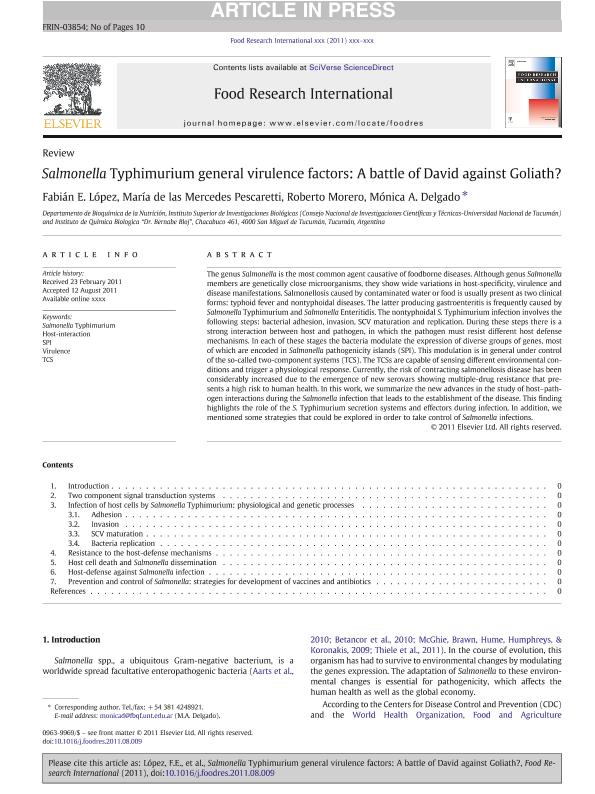Artículo
Salmonella Typhimurium general virulence factors: a battle of David against Goliath?
Lopez, Fabian Enrique ; Pescaretti, María de Las Mercedes
; Pescaretti, María de Las Mercedes ; Morero, Roberto Dionisio
; Morero, Roberto Dionisio ; Delgado, Monica Alejandra
; Delgado, Monica Alejandra
 ; Pescaretti, María de Las Mercedes
; Pescaretti, María de Las Mercedes ; Morero, Roberto Dionisio
; Morero, Roberto Dionisio ; Delgado, Monica Alejandra
; Delgado, Monica Alejandra
Fecha de publicación:
03/2012
Editorial:
Elsevier Science
Revista:
Food Research International
ISSN:
0963-9969
Idioma:
Inglés
Tipo de recurso:
Artículo publicado
Clasificación temática:
Resumen
The genus Salmonella is the most common agent causative of foodborne diseases. Although genus Salmonella members are genetically close microorganisms, they show wide variations in host-specificity, virulence and disease manifestations. Salmonellosis caused by contaminated water or food is usually present as two clinical forms: typhoid fever and nontyphoidal diseases. The latter producing gastroenteritis is frequently caused by Salmonella Typhimurium and Salmonella Enteritidis. The nontyphoidal S. Typhimurium infection involves the following steps: bacterial adhesion, invasion, SCV maturation and replication. During these steps there is a strong interaction between host and pathogen, in which the pathogen must resist different host defense mechanisms. In each of these stages the bacteria modulate the expression of diverse groups of genes, most of which are encoded in Salmonella pathogenicity islands (SPI). This modulation is in general under control of the so-called two-component systems (TCS). The TCSs are capable of sensing different environmental conditions and trigger a physiological response. Currently, the risk of contracting salmonellosis disease has been considerably increased due to the emergence of new serovars showing multiple-drug resistance that presents a high risk to human health. In this work, we summarize the new advances in the study of host-pathogen interactions during the Salmonella infection that leads to the establishment of the disease. This finding highlights the role of the S. Typhimurium secretion systems and effectors during infection. In addition, we mentioned some strategies that could be explored in order to take control of Salmonella infections. © 2011 Elsevier Ltd.
Palabras clave:
Host-Interaction
,
Salmonella Typhimurium
,
Spi
,
Tcs
,
Virulence
Archivos asociados
Licencia
Identificadores
Colecciones
Articulos(INSIBIO)
Articulos de INST.SUP.DE INVEST.BIOLOGICAS
Articulos de INST.SUP.DE INVEST.BIOLOGICAS
Citación
Lopez, Fabian Enrique; Pescaretti, María de Las Mercedes; Morero, Roberto Dionisio; Delgado, Monica Alejandra; Salmonella Typhimurium general virulence factors: a battle of David against Goliath?; Elsevier Science; Food Research International; 45; 2; 3-2012; 842-851
Compartir
Altmétricas



